The Clapham Society Local History Series — 41
Lost maps of Clapham
The story of Daniel Gould, surveyor and map-maker, 1769-1843
by Mike Tuffrey

“Trade is shocking bad in London” wrote Daniel Gould to his younger brother, Robert, in September of 1815, before enjoining him to “crack a bottle together” with the mutual friend bearing his letteri from Clapham to Bristol where their mother and wider family were living. Still, his spirits were good, he reported, “having more to do in the surveying this summer than I ever had”.
Please click images to see a larger version and click outside the image to return.
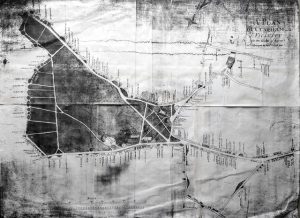
That summer’s surveying work was most likely making a remarkable map of the whole of the village of Clapham, detailing all the main houses around the Common and naming their occupants. Sadly, original versions of the map have disappeared from sight over the last 40 years, with this rather poor copy, illegible in parts, remaining in the care of the Clapham Society (Fig.2). How did the maps come to be made and where are they now?
Clapham in 1815

Our village (Fig.3) was being surveyed at a tumultuous time. The long Napoleonic wars were only just ending, the economy was depressed, while at sea the British navy was stepping up its attempts to stop the trans-Atlantic trade in slaves. In Clapham, the main protagonists for and against slavery were living side-by-side around the Common.
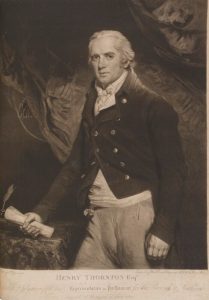
On Gould’s map we find Henry Thornton (1760-1815) (Fig.4), who had worked so closely with Wilberforce, at Battersea Rise on West Side, while opposite on North Side – the home of today’s Royal Trinity Hospice – was George Hibbert, leading promoter of slave holder interests. His family was one of the largest single beneficiaries of the so-called compensation fund when slavery itself was eventually outlawed in British jurisdictions two decades later.
Daniel Gould was one of the land tax assessors for Clapham and the 1815 plan was presumably commissioned by the tax authorities or the parish itself; he later did surveying work for the vestry – for example when they sold off the old workhouse in 1839 (site of Clapham North tube station today) (Fig. 5). Land tax records for the period up to 1830 have survived and so have the rare census returns for 1801, 1811 and 1821. Laying these lists of names, household composition and land tenure alongside Gould’s map allows us a remarkable insight into who was living where, and how and when they moved around the village – at least for those portions that remain legible. Its timing neatly fills a gap in a run of detailed parish maps – John Cary in 1790, Charles Smith in 1800, then H.N. Batten in 1827 and the tithe maps of 1838.
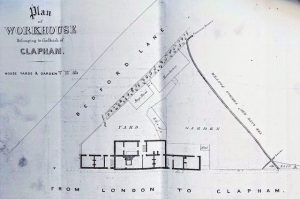
Traces of Gould’s other work show up in the records. He was surveyor to Thomas Cubitt’s new Clapham Park estate (Fig.6) and may have produced the estate plan of c1830 reproduced by Hermione Hobhouse in her 1971 book Thomas Cubitt: Master Builder – this too has sadly disappeared (Fig 7).

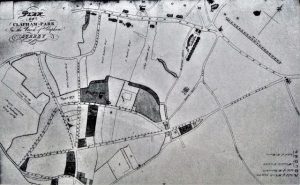
We also know he worked on maps for four large estates in Grenada around 1815, perhaps through a family connection in Bristol – another sign of how entrenched enslavement was in the economy at the time. Closer to home, for nearly three decades he was estate surveyor to Dr Edwards and his wife Mercy Cressingham at Tulse Hill, as they parcelled out their lands for house building in the first half of the 19th century (Fig 8).
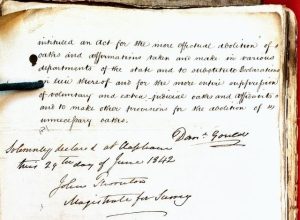
Family origins
So who was Daniel Gould and how did he arrive in Clapham? Born in Syston, near Bristol, in 1769, his father was steward to the Trotman estate there. In March 1793, he married Esther Shipley at St Anne’s, Syston. Her family were tallow chandlers, and it’s likely he was apprenticed to them. That was his stated trade when he and Esther moved to Clapham soon after the birth of their first child, another Daniel (1793-1840). They had nine children in all. Son William (1799-1873) became a prosperous iron merchant and later returned to Clapham to live in Crescent Grove. Another son, Robert (1802-74), was a solicitors’ clerk. (A descendant of his, Gould’s four times great granddaughter, has done much of the research cited here.) Other sons and unmarried daughters stayed living in Clapham.
The move to Clapham was probably prompted by a maternal relative, Robert Holbin (1748-1813), who was living here and working as a carpenter with several leading builders, well connected with the local land owners. It’s not clear how Gould learned his new profession. We can track his progress and moves within the village through snippets in the records. The family first lived on London Road close to the edge of the Common (roughly at today’s 180 Clapham High Street/junction with Venn Street). Around 1813/14, they moved to Acre Lane, on the north side, opposite today’s 146 Clapham Park Road, and remained there until about 1824. After that Daniel and Esther’s address is cited as Park Hill – the actual location was on today’s Clapham Park Road, just west of Abbeville Road, later known as Parson’s Corner.

Clearly well established by 1841, he had his portrait painted that year (Fig. 1) by local artist, William Tyrrel Thompson (1806-87). Daniel died in 1843, aged 74, and Esther the following year – both are buried in the old parish graveyard at St Pauls, Rectory Grove.
Missing maps
What do we know of the whereabouts of the missing 1815 map? At least two slightly different manuscript versions did survive. In 1976 the Clapham Antiquarian Society organised a local exhibition ii which included “a photocopy of a very detailed plan of the parish by Daniel Gould, 1815”.
There is no indication of how they came by it, although it is possible that copy is the one now in the care of the Clapham Society – consisting of A4 photocopies stuck together with glue, yellowing with age. That version is the one reproduced in Eric Smith’s guide to Clapham, the same as illustrated here (Fig2).
A second version is held by Lambeth Archives, who successfully acquired it when it came on the market in 1987, described at the time as among “Unusual items that have come up for sale”iii. A reduced-sized, low resolution copy was made for public use, rendering many of the names illegible. Frustratingly the full-sized original has since been misplaced, and searches have so far failed to locate it.

At one time a version of Gould’s map used to hang in the Reading Room of the Clapham Public Library. Contemporary resident Thomas Parsons iv (Fig. 9) recalled seeing it there, saying “It is very carefully prepared… Although this plan was made some thirty years before I began to take much interest in such things, little or no change did I find in the buildings, and no great alterations even in the names of the leading residents, most of whom were known to me personally, or by name as long ago as 1845.”
Daniel Gould’s possible map of Clapham Park estate is similarly ill-fated. A manuscript version Hobhouse saw (Fig. 7) was filed with the papers of renowned architect JB Papworth at RIBA v , but is no longer in place, seemingly uncatalogued. A later printed version has thankfully survived at the London Metropolitan Archives vi.
It is to be hoped that originals of all these maps can one day be located, copied to modern standards and made widely available. Meanwhile, frustration at lost records should not stand in the way of recognising the work of Daniel Gould at putting our village on the map, literally.
An earlier version of this article first appeared in the newsletter of the London Topographical Society issue 93, November 2021. https://londontopsoc.org/
Mike Tuffrey is a member of the Clapham Society local history group and is keen to hear from anyone with knowledge of Daniel Gould and his work.
Image list and credits
1. Portrait of Daniel Gould in 1841 by Clapham artist, William Tyrrel Thompson (Gould family)
2. Daniel Gould’s manuscript map of Clapham Common, 1815 (Clapham Society)
3. SE Corner of Clapham Common. Engraving by J Powell, published 1825 (Clapham Society)
4. Henry Thornton, by James Ward, after John Hoppner, 1802 (© National Portrait Gallery reproduced under Creative Commons)
5. Plan of Clapham Workhouse by Daniel Gould, 1839 (Lambeth Archives)
6. Notice advertising sale of plots on Cubitt’s new Clapham Park Estate, by Daniel Gould surveyor. (The Times July 6 1830)
7. Plan of Clapham Park estate c1830 (Hermione Hobhouse Thomas Cubitt: Master Builder)
8. Extract from declaration made by Daniel Gould concerning land sales in Tulse Hill for Dr Edwards and Mercy Cressingham, June 1842. Countersigned by John Thornton JP (1783-1866), cousin of Henry Thornton. (Lambeth Palace Archives)
9. Thomas Parsons (1838-1926), Clapham historian (Chronicles of Clapham, 1929)
i Original still in the possession of the Gould family
ii Clapham Antiquarian Society Occasional Sheet 340 July 1976: Account of exhibition held in June to mark the 200th anniversary of Holy Trinity Church, Clapham
iii The International Journal for the History of Cartography Vol. 39 (1987) pp. 94-104
iv Reminiscences of Thomas Parsons (1838-1926), reproduced in Michael Burgess’ Chronicles of Clapham (1929)
v J.B. Papworth Collection in the R.I.B.A. picture collection held at the V&A London
vi Brayley’s History of Surrey Volume III extra illustrated
(Please click the brower’s ‘Back’ button to return to the paragraph you were reading)